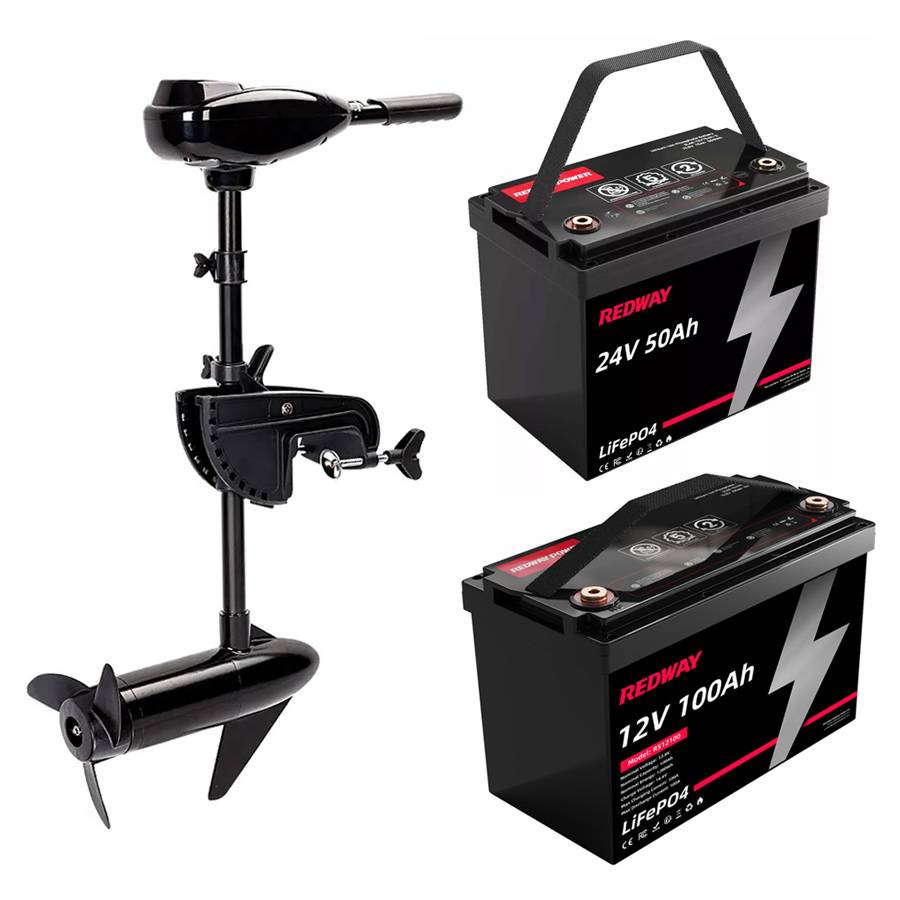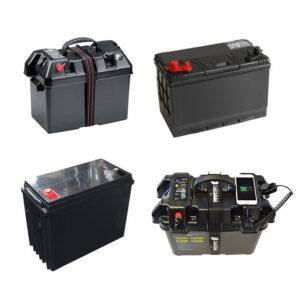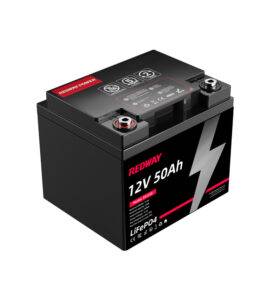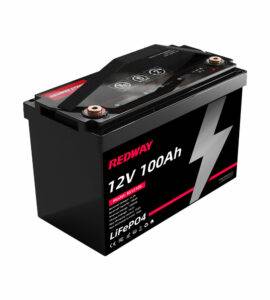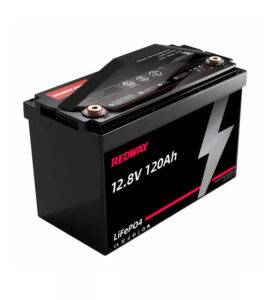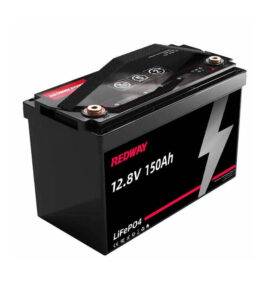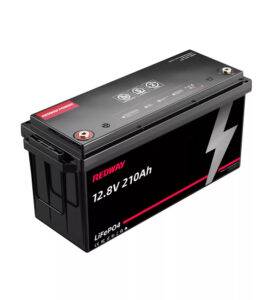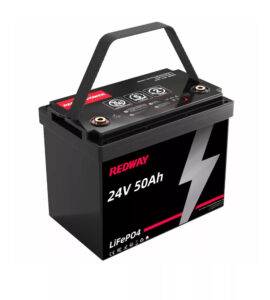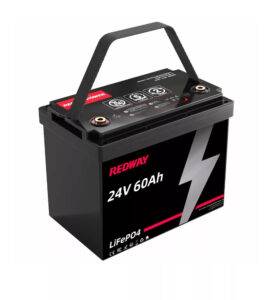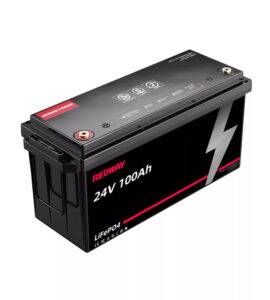Trolling Motor Lithium Batteries OEM/ODM Manufacturer
Trolling Motor Lithium Batteries, One-Stop Solution
Redway Power specializes in Trolling Motor Lithium Batteries, meticulously designed for powering electric trolling motors on boats. Crafted by Redway, these rechargeable lithium-ion batteries serve as the primary power source, offering high energy density, a lightweight design, and extended runtimes.
Tailored for anglers, Redway Power's Trolling Motor Lithium Batteries provide a reliable and efficient solution for quiet and precise navigation while fishing. With advanced lithium-ion technology, these batteries exemplify Redway Power's commitment to enhancing the overall performance of trolling motors, ensuring anglers experience a more efficient, portable, and convenient power solution for their boating and fishing activities.
Best Trolling Motor Lithium Batteries Manufacturer 2024
What is the wholesale price of a lithium battery?
You can click contact us or phone call us. We will give you multiple options of price.
Is Redway Power a trading company or factory?
Redway Power is a company with its own factory, integrating research, development, production, and sales.
How about the quality of Redway's LiFePo4 Battery product?
Redway Power boasts over 12 years of experience in LiFePO4 battery production and is an authorized supplier for CATL and BYD.
Can you do an OEM/ODM project?
Yes, we have engineers available to assist in designing and developing any related products.
What’s your MOQ?
MOQ varies according to battery voltage and capacity.
What payment terms can we accept?
We accept TT/Paypal/West Union, etc.
Trolling Motor Lithium Batteries Knowledge
Trolling motor lithium batteries are a preferred choice for powering trolling motors in boats and watercraft. These batteries offer numerous advantages over traditional lead-acid batteries. With their lightweight design, they provide enhanced maneuverability and speed, allowing boaters to navigate through the water with ease. Trolling motor lithium batteries are known for their longer lifespan, lasting up to 10 times longer than lead-acid batteries. They offer consistent power output throughout the entire discharge cycle, ensuring optimal performance for extended periods. With their quick charging capabilities, these batteries minimize downtime and maximize fishing time. Trust in the efficiency and reliability of trolling motor lithium batteries for an enhanced boating experience.
What are the best trolling motor batteries available?
- Recommended Batteries: Some of the best trolling motor batteries available include the Pro-Guide Lithium, Deka AGM, Optima OPT 8016 Deep Cycle Marine Battery, and Bass Pro Shops Power Series Deep Cycle AGM.
- Performance and Reliability: These batteries offer high performance and reliability for trolling motors, ensuring optimal power delivery and longer-lasting performance.
- Lithium and AGM Options: Lithium batteries are known for their lightweight design and long-lasting power, while AGM batteries excel in deep cycle capabilities.
Are trolling motor lithium batteries more efficient than lead-acid batteries?
- Lithium Battery Advantages: Trolling motor lithium batteries offer several advantages over lead-acid batteries. They have 25-50% higher capacity, providing up to 2x as many hours of power compared to lead-acid batteries.
- Longer Lifespan: Lithium batteries have a longer lifespan, resulting in cost savings in the long run.
- Consistent Power Delivery: Lithium batteries provide full voltage during the discharge, ensuring consistent power delivery.
What are the benefits of a lithium-ion trolling motor battery?
- Compactness and Lightweight Design: Lithium-ion batteries are more compact and lighter compared to lead-acid batteries, making them easy to handle and install.
- Higher Energy Density: With a higher energy density, lithium-ion batteries can store more energy, resulting in longer run times and improved performance for trolling motors.
- Faster Charging and Consistent Voltage Output: Lithium-ion batteries offer faster charging and consistent voltage output throughout the discharge, ensuring reliable power delivery.
- Longer Lifespan and Reduced Maintenance: Lithium-ion batteries have a longer lifespan and require less maintenance compared to lead-acid batteries, providing cost savings in the long run.
What is the best trolling motor battery for long-lasting performance?
- LiFePO4 Battery Advantages: LiFePO4 batteries are safe, lightweight, and offer significantly longer run times compared to other battery types.
- Excellent Performance and Durability: LiFePO4 batteries provide excellent performance and durability, making them ideal for extended use on the water.
- Consider Amp-Hour Rating: When selecting a trolling motor battery, consider a deep cycle marine battery with a high amp-hour rating, preferably 110 amp-hours or more, for long-lasting performance.
What makes a good trolling motor battery?
- Deep Cycle Marine Battery: A good trolling motor battery should be a deep cycle marine battery, designed to provide sustained power over an extended period.
- High Amp-Hour Rating: Look for a battery with a high amp-hour rating, preferably at least 100 amp-hours or more, to ensure sufficient power for longer trips.
- Group 27 or Higher Rating: The battery should have a Group 27 or higher rating, indicating its size and capacity.
- Good Reserve Capacity: A good trolling motor battery should have a good reserve capacity, ensuring consistent power output throughout the discharge.
- Long Lifespan and Compatibility: Consider the battery’s lifespan and compatibility with your specific trolling motor model to ensure optimal performance.
How do I choose a 12-volt trolling motor?
- Suitable for Lower Thrust: A 12-volt trolling motor is typically suitable for boats with 55 pounds of thrust or less.
- Consider 24-Volt System: If your boat requires 68-80 pounds of thrust, you may need to consider a 24-volt system.
- Battery Voltage and Compatibility: It is recommended to have one battery for every 12 volts in your trolling system. Ensure that your boat’s electrical system is compatible with the selected voltage.
What is the best combination of trolling motor and battery?
- High-Quality Trolling Motor: Start by choosing a high-quality trolling motor that suits your boat size and desired power.
- Deep Cycle Marine Battery: Pair the trolling motor with a deep cycle marine battery, such as AGM (absorbent glass mat) or lithium-ion batteries, known for their performance and durability.
- Consider Runtime and Power: Consider the desired runtime and power requirements for your trolling motor to select a battery with a sufficient amp-hour rating.
- Compatibility: Ensure that the battery and trolling motor are compatible in terms of voltage and electrical system requirements.
How does a 24-volt trolling motor compare to a 12-volt model?
- Power and Thrust:
- A 24-volt trolling motor offers more power and thrust compared to a 12-volt model.
- It is better suited for larger boats and challenging conditions, providing enhanced performance and maneuverability.
- Efficiency:
- A 24-volt trolling motor is generally more efficient than a 12-volt model.
- It requires less current to deliver the same power, resulting in longer battery life and improved overall efficiency.
- Price and Weight:
- It’s important to consider that a 24-volt trolling motor may be more expensive and heavier than a 12-volt model.
- These factors should be taken into account based on individual needs, budget, and vessel requirements.
How long does a 12-volt trolling motor battery last?
- Amp-Hour Rating:
- The amp-hour rating of the battery indicates its capacity to supply power.
- For example, a battery with a 50 amp-hour rating can power a trolling motor with a 10-amp draw for approximately 5 hours.
- Motor Draw:
- The amperage draw of the trolling motor affects the battery’s runtime.
- Higher amperage draws deplete the battery more quickly, resulting in a shorter runtime.
- Battery Capacity and Conditions:
- The overall capacity of the battery and its state of charge impact the runtime.
- Factors such as speed, wind, water conditions, and the battery’s efficiency also contribute to the actual runtime.
Why choose a deep cycle trolling motor battery over a regular battery?
- Longevity:
- Deep cycle batteries are built to withstand frequent deep discharges and recharges, resulting in longer-lasting performance compared to regular batteries.
- Their design ensures durability and reliability for prolonged use in trolling motor applications.
- Power Delivery:
- Deep cycle batteries deliver a steady and consistent power output over an extended period.
- This consistent power supply is essential for trolling motors that require sustained power for longer durations.
- Deep Discharge Capability:
- Deep cycle batteries can handle deep discharge cycles without significant damage.
- This capability allows for efficient use of stored energy and extends the battery’s overall lifespan.
- Recharge Efficiency:
- Deep cycle batteries have a higher recharge efficiency, enabling them to accept and store energy more effectively during the recharging process.
- This efficiency ensures that the battery can recharge efficiently and be ready for the next use.
What is the best marine battery for a trolling motor?
- Dakota Lithium 12V 100AH:
- Known for their longevity and lightweight design, Dakota Lithium batteries provide excellent performance for trolling motors.
- These batteries offer a balance between capacity, weight, and durability.
- MillerTech Lithium 12V Dual Purpose 135Ah:
- Designed for both starting and deep cycling applications, MillerTech Lithium batteries provide high capacity and reliable power for trolling motors.
- These batteries are suitable for users who require versatility and long-lasting performance.
- Tracker Lithium 12 Volt 60 AH Battery:
- Tracker Lithium batteries offer a balance of performance and affordability, making them a popular choice for trolling motors.
- These batteries provide reliable power for various trolling motor applications.
- ZPRO Lithium 12V 50AH:
- ZPRO Lithium batteries are known for their lightweight design, high energy density, and long lifespan.
- These batteries are suitable for users who prioritize portability and durability.
How do I choose a deep cycle battery for my trolling motor?
- Amp-Hour (Ah) Rating:
- Look for a deep cycle battery with a higher Ah rating, as it indicates a larger capacity and longer runtime.
- Higher Ah ratings provide more power and allow for extended usage.
- Group Size:
- Consider the recommended group size for your trolling motor.
- Common group sizes include 24, 27, and 31, with larger group sizes typically offering higher capacities.
- Reserve Capacity (RC):
- RC measures the battery’s ability to provide power over a specified period.
- Higher RC values indicate longer-lasting performance and a greater capacity to handle continuous usage.
- Battery Type:
- Select the appropriate battery type based on your needs and budget.
- Options include flooded lead-acid, AGM (Absorbent Glass Mat), or lithium-ion batteries, each with its own advantages and considerations.
- Brand and Quality:
- Choose a reputable brand known for producing high-quality deep cycle batteries.
- Quality batteries offer better performance, durability, and reliability.
What are the advantages of a 36-volt trolling motor?
- Increased Power:
- A 36-volt trolling motor delivers more power and thrust compared to lower voltage models.
- With over 100 pounds of thrust, it provides the necessary power for challenging conditions and larger watercraft.
- Longer Runtime:
- The higher voltage of a 36-volt trolling motor battery typically results in a longer runtime.
- This extended runtime allows for more time on the water without needing to recharge or replace the battery.
- Enhanced Performance:
- The increased power and thrust of a 36-volt trolling motor contribute to improved performance.
- It provides better maneuverability, especially in challenging conditions or when navigating larger watercraft.
- Suitable for Larger Boats:
- The higher power output of a 36-volt trolling motor makes it well-suited for medium-sized and larger vessels.
- It delivers the necessary thrust and power to effectively navigate and control larger watercraft.
How does a 36V trolling motor improve performance?
- Increased Power and Thrust:
- A 36V trolling motor delivers more power and thrust compared to lower voltage models.
- This increased power allows for better maneuverability, especially in challenging conditions or when operating larger watercraft.
- Enhanced Speed Capabilities:
- The higher voltage of a 36V motor enables increased speed capabilities.
- This allows for faster navigation and quicker response times on the water.
- Extended Runtime:
- Despite drawing more power, a 36V trolling motor can offer longer runtime due to the higher capacity of the battery bank.
- This extended runtime allows for more time on the water without needing to recharge or replace the batteries.
- Improved Power Delivery:
- The higher voltage of a 36V motor ensures a more consistent and efficient power delivery to the propeller.
- This results in smoother and more reliable performance on the water.
What size of solar panel for large power stations?
When it comes to powering large power stations with solar energy, the size of the solar panel is crucial. You’ll need a robust and efficient system to generate enough power to keep your station running smoothly. Opting for larger panels will ensure that you can harness more sunlight and convert it into usable electricity.
Consider factors like the power consumption of your station, sunlight exposure in your location, and any additional equipment or devices connected to the system. A larger solar panel array will typically be necessary for stations with higher energy demands or those located in areas with less consistent sunlight.
Investing in quality panels with high efficiency ratings will maximize the amount of electricity generated, even on cloudy days. Pairing these panels with a reliable storage solution like lithium batteries can help you store excess energy for use when sunlight is limited.
Remember, sizing your solar panel system correctly is essential for ensuring uninterrupted power supply to your large power station.
Recommended onboard marine charger for lithium batteries?
When it comes to charging your trolling motor lithium batteries onboard your marine vessel, choosing the right charger is crucial. A recommended option for this task is the Dakota Lithium 12V 20 Amp IP67 Waterproof Onboard Marine Charger. This charger is specifically designed to efficiently and safely charge Dakota Lithium batteries while out on the water.
The Dakota Lithium onboard marine charger features a waterproof and durable design, making it perfect for harsh marine environments. It also provides a reliable and consistent charge to ensure that your lithium batteries are always ready for action when you need them most.
With its intelligent charging technology, this onboard marine charger helps prolong the lifespan of your lithium batteries by preventing overcharging or undercharging. Additionally, its compact size makes it easy to install in any boat setup without taking up too much space.
Investing in a high-quality onboard marine charger like the Dakota Lithium model ensures that you can keep your trolling motor running smoothly and efficiently throughout all your fishing adventures on the water.
How to connect, store, and charge Dakota Lithium batteries?
When it comes to Dakota Lithium batteries, ensuring proper connection, storage, and charging practices is essential for optimal performance.
To connect the batteries, always follow the manufacturer’s guidelines regarding wiring and connections to prevent any damage or safety hazards. Make sure to securely fasten all connections and double-check them before each use.
When storing Dakota Lithium batteries, keep them in a cool, dry place away from direct sunlight and extreme temperatures. Avoid placing them near flammable materials or liquids.
For charging the batteries, use a compatible charger designed for lithium batteries. Follow the recommended charging voltage and current settings specified by Dakota Lithium for safe and efficient recharging.
Regularly inspect the batteries for any signs of damage or wear and tear. If you notice any issues, discontinue use immediately and contact Dakota Lithium customer support for assistance.
By following these simple steps on how to connect, store, and charge your Dakota Lithium batteries properly, you can ensure their longevity and reliability in powering your trolling motor adventures.
What’s the warranty period for Dakota Lithium batteries?
When it comes to Dakota Lithium batteries, one key aspect that customers often inquire about is the warranty period offered by the company. Understanding the warranty details can provide peace of mind and assurance regarding your purchase.
Dakota Lithium offers an impressive 11-year warranty on their batteries, showcasing their confidence in the quality and durability of their products. This extensive warranty period sets them apart from other competitors in the market and highlights their commitment to customer satisfaction.
Having such a long warranty period means that you can trust in the longevity of your investment. It also reflects Dakota Lithium’s dedication to providing reliable power solutions for various applications, including trolling motors and marine use.
By offering an industry-leading 11-year warranty, Dakota Lithium not only demonstrates their belief in the performance of their batteries but also shows that they value customer loyalty and satisfaction above all else.
How to stay informed about Dakota Lithium Batteries?
To stay informed about Dakota Lithium Batteries, the best way is to subscribe to their newsletter. By signing up, you’ll receive regular updates on new products, promotions, and industry news directly to your inbox. Additionally, following Dakota Lithium on social media platforms like Facebook and Instagram can keep you in the loop with real-time updates and engaging content.
Visiting their website frequently is also a great way to stay informed about any product releases or announcements. The blog section on their website often features informative articles and guides related to lithium batteries that can enhance your knowledge as well.
Attending trade shows or events where Dakota Lithium participates can give you firsthand information about their latest innovations and technologies. Interacting with their team members at these events can provide valuable insights into how to optimize the performance of your trolling motor lithium batteries.
Maintenance and Care Tips for Trolling Motor Lithium Batteries
Taking care of your trolling motor lithium batteries is crucial to ensure their longevity and optimal performance. Here are some maintenance and care tips to keep in mind:
1. **Regular Charging**: Keep your Dakota Lithium batteries charged when not in use. It’s best to store them at around 50% charge for extended periods.
2. **Avoid Discharge**: Try not to fully discharge your batteries if possible, as this can reduce their lifespan.
3. **Proper Storage**: Store your lithium batteries in a cool, dry place away from direct sunlight or extreme temperatures.
4. **Clean Connections**: Periodically check and clean the battery terminals and connections to prevent any buildup that could impede performance.
5. **Avoid Overheating**: Be mindful of heat generation during charging or discharging, as excessive heat can damage lithium batteries.
By following these simple maintenance tips, you can prolong the life of your trolling motor lithium batteries and enjoy many successful fishing trips powered by reliable energy storage solutions like Dakota Lithium!
How can LiPo cells be protected in garments?
When it comes to integrating LiPo cells into wearable garments, protection is key. One way to safeguard these batteries is by utilizing specialized pouches or compartments designed to secure the cells in place and prevent any accidental damage. Additionally, incorporating impact-resistant materials around the battery area can provide an extra layer of defense against potential impacts or bumps.
Furthermore, implementing temperature monitoring sensors within the garment can help regulate the heat generated during charging or discharging, ensuring that the batteries operate within safe temperature ranges. Proper ventilation in the garment design is also crucial to dissipate any excess heat that may build up during use.
Ensuring proper handling and care when designing garments with integrated LiPo cells is essential to maximize their performance while prioritizing safety for users.
Are LiPo batteries safe for wearable tech?
When it comes to wearable tech, safety is a top priority. LiPo batteries have gained popularity for their compact size and lightweight properties, making them ideal for wearable devices.
These batteries are generally safe for use in wearable tech when handled properly and integrated into the design with caution. It’s crucial to ensure that the battery is well-protected within the garment to prevent any mishaps.
LiPo batteries offer a better discharge curve compared to other types of batteries, providing a steady power supply for continuous usage in wearable devices without compromising on performance or efficiency.
Manufacturers often opt for LiPo batteries in wearable tech due to their high energy density and stability, allowing for longer usage times between charges while maintaining safety standards.
By following proper handling procedures and integrating safeguards into the design of wearable devices, LiPo batteries can be safely utilized to power our favorite gadgets on-the-go.
Why do LiPo batteries have a better discharge curve?
LiPo batteries are known for their superior discharge curve compared to other battery types. This means that as the battery is drained, it maintains a more consistent and stable voltage output, providing steady power to the device until it’s nearly depleted. This feature is crucial in applications where a constant power supply is required, such as RC cars or drones.
The chemistry of LiPo batteries allows them to deliver high currents without experiencing significant voltage drops. This makes them ideal for powering devices that demand bursts of energy, like electric vehicles or power tools. The ability of LiPo batteries to maintain performance under varying loads gives them an edge over other batteries in terms of efficiency and reliability.
With a better discharge curve, LiPo batteries can deliver consistent performance throughout their cycle life, making them a popular choice for high-performance electronics and gadgets. Their ability to provide stable power output sets them apart from traditional battery technologies, showcasing why they are favored in various industries where reliable energy storage is essential.
How do Li-Ion batteries differ in energy density and stability?
Li-Ion batteries boast a higher energy density compared to LiPo cells, making them popular in various devices. This means they can store more energy in the same size battery, providing longer-lasting power. In terms of stability, Li-Ion batteries are known for their robust and reliable performance under different conditions.
Their stable chemistry ensures consistent power output without sacrificing safety. With advancements in technology, Li-Ion batteries have become even more efficient and durable over time. Their ability to maintain a steady voltage throughout the discharge cycle enhances the overall user experience.
While both battery types have their strengths, the superior energy density and stability of Li-Ion batteries make them a top choice for many applications requiring long-lasting and reliable power sources.
What are the discharge ratings for LiPo and Li-Ion batteries?
When it comes to discharge ratings, LiPo batteries generally have higher discharge rates compared to Li-Ion batteries. This means that LiPo cells can deliver power more rapidly, making them ideal for applications that require high bursts of energy. LiPo batteries are known for their ability to handle continuous high-discharge currents without significant voltage drops.
On the other hand, while Li-Ion batteries may not have as high discharge rates as LiPos, they are still commonly used in various devices due to their stability and energy density. These batteries provide a more steady and consistent flow of power over a longer period, which is preferred in certain applications where sustained performance is key.
Understanding the discharge ratings of both battery types is crucial when selecting the right power source for your specific needs. Whether you prioritize rapid bursts of energy or long-lasting performance, choosing between LiPo and Li-Ion will depend on your unique requirements.
Can LiPo batteries discharge at higher rates than Li-Ion batteries?
LiPo batteries are known for their ability to discharge at higher rates compared to Li-Ion batteries. This feature makes them popular in applications that require quick bursts of power, such as RC cars and drones. The high discharge rate capability of LiPo batteries is due to their lower internal resistance, allowing them to deliver energy more efficiently.
In contrast, Li-Ion batteries have a lower discharge rate but offer better stability and energy density. While they may not be suitable for high-performance applications like RC vehicles, they excel in providing stable power output over a longer period.
When considering which battery type to use, it’s essential to weigh the requirements of the specific application. If you need high currents and rapid power delivery, LiPo batteries are the way to go. However, if stability and energy density are your priorities, then Li-Ion batteries would be the better choice. Each type has its strengths and limitations based on the intended use case.
What are the safety precautions for LiPo and Li-Ion batteries?
When it comes to handling LiPo and Li-Ion batteries, safety is key. Always store batteries in a cool, dry place away from direct sunlight and extreme temperatures. Inspect the batteries regularly for any signs of damage or swelling.
Use the correct charger specifically designed for these battery types to avoid overcharging or undercharging, which can lead to potential hazards. Never leave charging batteries unattended or charge them overnight.
Avoid puncturing or exposing the batteries to water as this can result in a dangerous chemical reaction. When transporting spare batteries, ensure they are stored securely in an appropriate container to prevent short circuits.
Always follow manufacturer guidelines and recommendations for safe handling practices to minimize risks associated with using these powerful energy sources.
Why are LiPo batteries used in RC cars and phones, while Li-Ion batteries are used in flashlights?
LiPo batteries are the go-to choice for RC cars and phones due to their high discharge rates, providing the power needed for fast acceleration. Their compact size also makes them ideal for these applications – perfect for fitting into small spaces without compromising performance.
On the other hand, Li-Ion batteries are commonly found in flashlights because of their stable energy density and longer cycle life. Flashlights require a reliable power source that can sustain consistent brightness over extended periods, which Li-Ion batteries excel at delivering.
The unique characteristics of each battery type cater to specific needs in different devices. RC cars demand quick bursts of power, making LiPo batteries indispensable. Phones rely on efficient energy usage and fast charging capabilities provided by LiPo cells.
In contrast, flashlights prioritize longevity and reliability, qualities inherently present in Li-Ion batteries. The diverse nature of these devices drives the selection of battery types suited to optimize their performance levels effectively.
How do Li-Ion and LiPo batteries differ in key characteristics?
When comparing Li-Ion and LiPo batteries, key differences lie in their chemical composition and performance characteristics. Li-Ion batteries are known for their stable energy density but have a lower discharge rate compared to LiPo batteries. On the other hand, LiPo batteries offer higher discharge rates, making them ideal for applications requiring high currents like RC cars and drones.
Li-Ion batteries generally provide a longer lifespan due to their stable chemistry, while LiPo batteries may degrade faster if not properly maintained or charged. In terms of safety precautions, both battery types require careful handling to prevent overheating or short circuits that could lead to potential hazards.
Understanding the distinct characteristics of each battery type is crucial when selecting the right power source for specific devices or projects.
Which battery type, LiPo or Li-Ion, provides high currents and is safer?
When it comes to providing high currents, LiPo batteries are the go-to choice for many applications. Their design allows for a higher discharge rate compared to Li-Ion batteries, making them ideal for power-hungry devices like RC cars and drones. The ability to deliver a surge of power quickly is one of the reasons why LiPo batteries are favored in these scenarios.
As for safety, both LiPo and Li-Ion batteries have their own set of precautions that need to be taken into consideration. While LiPo batteries can be more prone to issues like swelling or catching fire if mishandled, proper care and maintenance can mitigate these risks. On the other hand, Li-Ion batteries are generally considered safer due to their more stable chemistry.
When looking for a battery type that can handle high currents while prioritizing safety measures, it’s essential to weigh the specific requirements of your device and ensure proper handling practices are in place.
Why do RC cars and planes use LiPo batteries, and flashlights use Li-Ion?
When it comes to choosing between LiPo and Li-Ion batteries for different applications, understanding their key characteristics is crucial. LiPo batteries are preferred in RC cars and planes due to their high discharge rates, which provide the necessary power for these high-performance devices. On the other hand, flashlights typically use Li-Ion batteries because of their stable energy density and safety features, making them a reliable choice for everyday use.
Selecting the right type of battery depends on the specific requirements of the device or application. Whether it’s powering up an RC vehicle for an adrenaline-fueled race or illuminating your path during a nighttime adventure, knowing the differences between LiPo and Li-Ion batteries will help you make an informed decision that ensures optimal performance and safety.
Is a 50AH Battery Sufficient for a Range of Trolling Motors and More?
Yes. A 50AH battery can be sufficient for a range of trolling motors, depending on factors such as the motor’s power draw and desired runtime. While it may provide adequate power for some applications, others may require higher capacity batteries. Consider the specific needs of your trolling motor and desired runtime when selecting a battery.
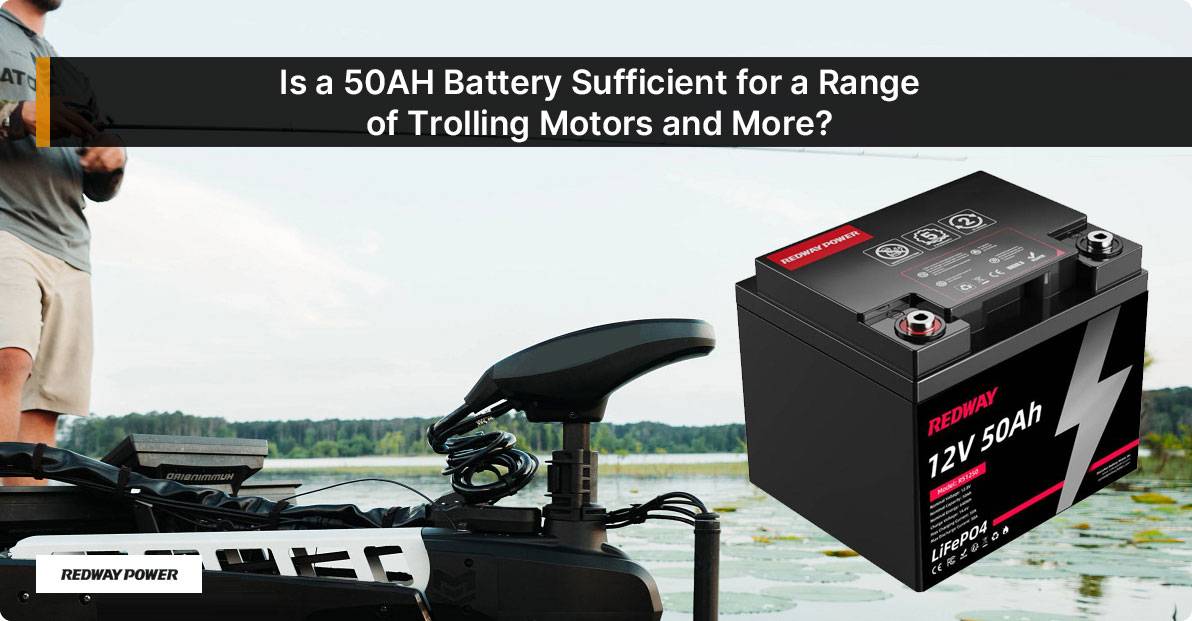
- Consider the Motor’s Power Draw:
- The power draw of the trolling motor is an important factor in determining the battery’s suitability.
- A 50AH battery may be sufficient for motors with lower power draws, while higher power draws may require higher capacity batteries.
- Evaluate Desired Runtime:
- The desired runtime of the trolling motor is another consideration when selecting a battery.
- A 50AH battery may be suitable for shorter outings or applications with intermittent usage, while longer runtime requirements may necessitate higher capacity batteries.
- Tailor Battery Selection to Specific Needs:
- Selecting the appropriate battery for a trolling motor involves considering the specific needs of the motor and the desired runtime.
- Evaluate the power requirements and runtime expectations to ensure the chosen battery meets the necessary criteria.
Are Lithium Batteries Compatible with Trolling Motors?
- Manufacturer’s Recommendations:
- Different trolling motor manufacturers may have varying guidelines regarding the compatibility of lithium batteries.
- Some manufacturers advise against using lithium batteries with their products, while others state that their trolling motors can run on lithium-ion batteries.
- Consider Specific Motor Requirements:
- When considering lithium batteries for a trolling motor, it is important to review the manufacturer’s specifications and requirements.
- Factors such as voltage, capacity, and power draw should be considered to ensure compatibility and optimal performance.
- Ensure Compatibility:
- To ensure compatibility, it is crucial to follow the manufacturer’s guidelines and recommendations.
- Review the trolling motor’s documentation or consult with the manufacturer directly to determine if lithium batteries are compatible and suitable for the specific motor.
What Battery Do I Need For My Trolling Motor?
When selecting a battery for a trolling motor, a 12-volt deep cycle marine battery with at least a 110 amp hour (AH) rating is often recommended. Group 27 size or larger batteries are commonly used. The higher the amp-hour rating, the longer the trolling motor will run. Consider the specific power requirements and desired runtime when choosing a battery for your trolling motor.
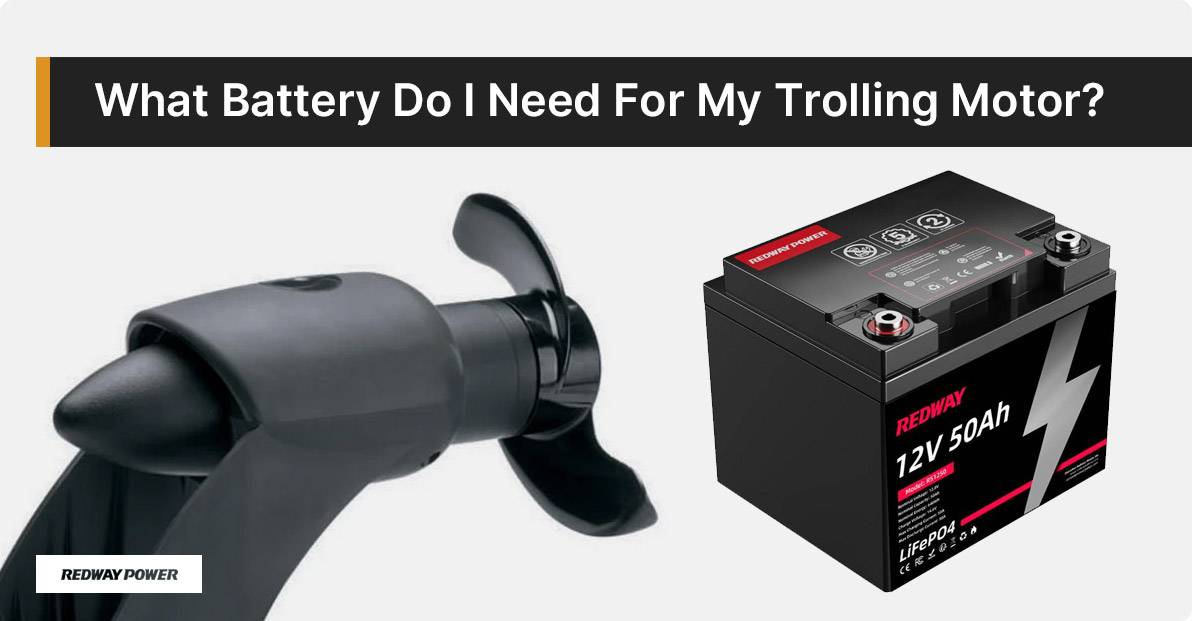
- Consider the Motor’s Power Requirements:
- Evaluate the power requirements of the trolling motor to determine the appropriate battery capacity.
- A 12-volt deep cycle marine battery is often suitable for most trolling motors, but the amp hour (AH) rating should be considered based on the motor’s power draw.
- Look for a Suitable Group Size:
- Group sizes like Group 27 or larger are commonly used for trolling motor batteries.
- Larger group sizes provide higher capacity and longer runtime for the trolling motor.
- Amp-Hour Rating and Runtime:
- The amp-hour (AH) rating of the battery determines the runtime of the trolling motor.
- A higher amp-hour rating will provide a longer runtime, allowing for extended usage on the water.
What Size Lithium Battery Do I Need for a 55 lb Thrust Trolling Motor?
- Consider Voltage and Motor Thrust:
- The voltage and thrust of the trolling motor play a role in determining the size of the lithium battery needed.
- A 12V battery is commonly used for trolling motors, and a capacity of 50Ah or higher is often suitable for a 55 lb thrust motor.
- Refer to Manufacturer Recommendations:
- To ensure the optimal battery size, it is important to refer to the manufacturer’s recommendations for the specific trolling motor.
- Manufacturers may provide guidelines or specifications regarding the suitable battery size for their trolling motors.
ust, up to 80 lbs, you’ll need two 12-volt batteries to provide a total of 24 volts.
How to Select the Right Charger for Lithium Trolling Motor Batteries?
- Voltage Compatibility:
- Match the voltage output of the charger with the voltage requirements of the battery.
- Using a charger with the wrong voltage can damage the battery or the charger.
- Charger Type:
- Look for a charger that supports lithium battery charging, specifically lithium iron phosphate (LiFePO4) batteries.
- These chargers are designed to provide the appropriate charging parameters for lithium batteries.
- Charger Capacity:
- Consider the charger capacity to ensure it can handle the charging needs of the lithium trolling motor batteries.
- The charger should be suitable for the battery size and capacity.
How Does Redway Power Lithium Claim to Outperform Traditional Batteries?
Redway Power Lithium batteries claim to outperform traditional batteries through enhanced performance, longer cycle life, lightweight design, and efficient charging capabilities. These lithium batteries often have higher energy density, providing more power in a compact size. They are also known for their durability and long-lasting performance.
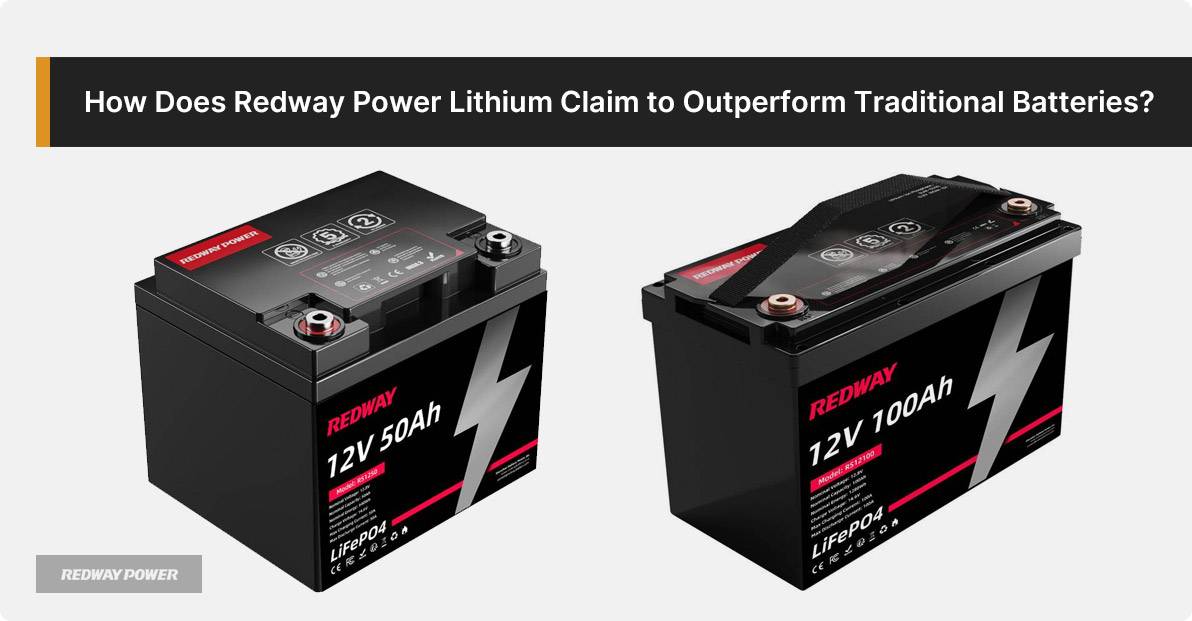
What Types of Batteries Are Available from Redway Power?
Redway Power lithium batteries accomplish this and surpass existing batteries in the market due to our focus on product development. We have oneof the largest lithium product o erings available with 12V, 24V, 48V, 51.2V, 60V, 72V, 76V, 80V to 600V batteries that power a range of applications.


